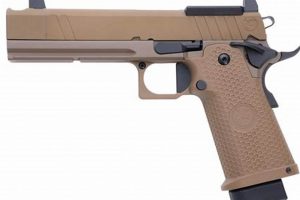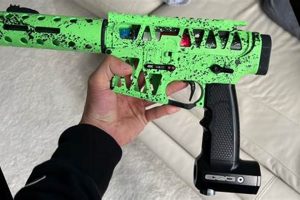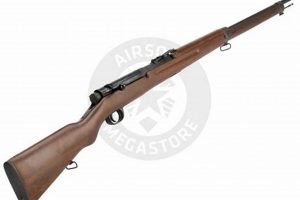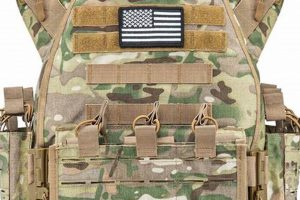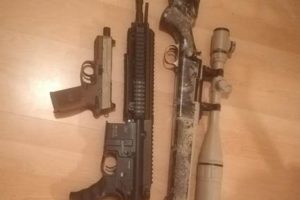This specialized segment within the airsoft market focuses on replicating the form and function of real-world firearms as accurately as possible. These replicas often prioritize authentic materials, detailed construction, and realistic operation, offering a higher level of realism compared to standard airsoft guns. For instance, a product in this category might feature stamped steel receivers, wood furniture, and a gas blowback system designed to mimic the recoil and cycling of a genuine firearm.
The significance of these high-fidelity replicas lies in their appeal to collectors, historical reenactors, and airsoft enthusiasts seeking an immersive experience. Their meticulous design provides benefits such as enhanced training opportunities, allowing users to practice firearm handling skills in a safe and controlled environment. Historically, the demand for such replicas stems from a desire for realism that transcends purely recreational airsoft activities, catering to a niche market prioritizing authenticity and detail.
The following sections will delve into the specific characteristics of these replicas, examining their construction materials, internal mechanisms, and the degree to which they mirror their real-world counterparts. Further discussion will explore the implications for gameplay, training applications, and the impact on the broader airsoft community.
Guidelines for Optimal Use
These recommendations are designed to maximize the lifespan and performance of these specialized airsoft replicas. Adherence to these guidelines will ensure a more satisfying and reliable user experience.
Tip 1: Implement Consistent Maintenance Schedules: Regular disassembly, cleaning, and lubrication of internal components are crucial. Utilize appropriate lubricants and solvents specifically designed for airsoft guns to prevent damage to seals and other delicate parts.
Tip 2: Employ Proper Ammunition: Use only high-quality, seamless BBs of the correct weight and diameter. Inferior ammunition can cause jamming, barrel damage, and inconsistent performance.
Tip 3: Adhere to Designated Power Sources: Employ the specified gas type or battery voltage as indicated by the manufacturer. Utilizing incorrect power sources can lead to catastrophic failures and void any warranties.
Tip 4: Practice Safe Handling Procedures: Treat the replica as one would a real firearm. Always point the barrel in a safe direction, keep the finger off the trigger until ready to fire, and ensure the replica is unloaded when not in use.
Tip 5: Store Properly When Not in Use: Store the replica in a cool, dry environment away from direct sunlight and extreme temperatures. This will prevent warping, rust, and degradation of internal components.
Tip 6: Inspect Before Each Use: Prior to each use, thoroughly inspect the replica for any signs of wear, damage, or loose components. Address any issues immediately to prevent further damage or malfunction.
Tip 7: Seek Professional Repairs: When encountering complex mechanical issues, consult a qualified airsoft technician. Attempting repairs without the necessary expertise can exacerbate the problem and potentially render the replica unusable.
By following these guidelines, users can significantly extend the operational life and maintain the peak performance of their high-fidelity airsoft replicas. Consistent adherence to these practices minimizes the risk of damage and ensures a consistently reliable and enjoyable experience.
The subsequent sections will explore advanced modifications and performance enhancements, providing further insights into optimizing the functionality of these specialized airsoft replicas.
1. Authenticity
Within the specialized domain of high-fidelity airsoft replicas, authenticity serves as a core principle, guiding design, manufacturing, and the overall user experience. It represents a commitment to mirroring the characteristics of real firearms as closely as possible, appealing to enthusiasts who value historical accuracy and realistic operation.
- External Replication
This facet focuses on replicating the external appearance of real firearms, including dimensions, markings, and materials. Examples include the use of stamped steel receivers, wood furniture, and accurate engravings of manufacturer markings. The impact of this replication is to provide a visually convincing representation of the real weapon, enhancing the sense of immersion for the user.
- Internal Functionality
Authenticity extends to the internal mechanisms, aiming to replicate the operation of the real firearm. This includes features such as realistic gas blowback systems, functional bolt carriers, and accurate trigger mechanisms. The goal is to provide a tactile and operational experience that closely mimics the handling of the real weapon, adding to the realism and training value.
- Material Fidelity
The use of authentic materials is a crucial aspect of authenticity. This includes employing steel, wood, and polymers that match the materials used in the real firearm. The selection of materials not only contributes to the visual realism but also impacts the weight, feel, and overall durability of the replica.
- Historical Accuracy
For certain replicas, historical accuracy is paramount. This involves replicating specific models from particular eras, ensuring that all details, including markings, finishes, and accessories, are consistent with the historical period. This facet appeals to collectors and historical reenactors who seek an accurate representation of firearms used in specific historical contexts.
The pursuit of authenticity within the realm of these high-fidelity airsoft replicas significantly enhances their value, appealing to a discerning audience that prioritizes realism and historical accuracy over purely recreational airsoft activities. This commitment to detail elevates these items beyond simple toys, transforming them into valuable training tools, collector’s items, and historically accurate representations of real firearms.
2. Durability
Durability assumes a critical role in the context of high-fidelity airsoft replicas, directly influencing their lifespan, performance consistency, and overall value. The inherent stresses of airsoft gameplay, coupled with the complex internal mechanisms of these replicas, necessitate robust construction and resilient components.
- Material Composition
The selection of materials fundamentally impacts durability. Replicas constructed with high-strength steel, reinforced polymers, and precision-machined metal alloys exhibit superior resistance to wear, impact, and environmental degradation. An example is the use of hardened steel gears within the gearbox, providing increased resistance to stripping and failure compared to standard alloys. Inferior materials lead to premature component failure and reduced operational lifespan.
- Construction Integrity
The method of assembly and the overall structural design significantly affect durability. Replicas featuring robust construction techniques, such as reinforced receivers, precision-fit components, and properly secured hardware, demonstrate enhanced resistance to the rigors of airsoft gameplay. Conversely, poorly assembled replicas with weak points are prone to breakage under stress.
- Component Resilience
The resilience of individual components directly influences the overall durability of the replica. Components such as the piston, cylinder, and hop-up unit are subjected to repeated stress during operation. High-quality components, manufactured to tight tolerances and employing durable materials, exhibit greater resistance to wear and tear, contributing to increased reliability and longevity.
- Environmental Resistance
Durability also encompasses resistance to environmental factors, such as moisture, temperature fluctuations, and exposure to ultraviolet radiation. Replicas designed with protective coatings, sealed components, and corrosion-resistant materials are better equipped to withstand these elements, preserving their performance and appearance over extended periods. Inadequate environmental protection can lead to rust, warping, and degradation of internal components.
These facets of durability collectively determine the long-term viability and performance of high-fidelity airsoft replicas. By prioritizing robust materials, sound construction, resilient components, and environmental resistance, manufacturers can produce replicas that withstand the demands of rigorous use, providing users with a reliable and enduring product.
3. Performance
The performance characteristics of these high-fidelity airsoft replicas are paramount, serving as a key differentiator between standard airsoft guns and those designed for enhanced realism and functionality. Performance, in this context, encompasses factors such as accuracy, range, rate of fire, and consistency, all of which contribute directly to the user’s experience. A well-performing replica delivers consistent shot placement, enabling accurate targeting at extended ranges, while a high rate of fire allows for effective suppression. Conversely, a poorly performing replica exhibits inconsistent shot patterns, limited range, and unreliable operation, diminishing the user’s effectiveness and enjoyment.
The internal components of the airsoft gun, such as the hop-up unit, barrel, and gearbox, exert a significant influence on performance. The hop-up unit imparts backspin to the BB, extending its range and improving accuracy. A precision-grade inner barrel ensures consistent shot trajectory, minimizing deviation. The gearbox, responsible for propelling the BB, must deliver consistent power output and a reliable rate of fire. For instance, upgrading the inner barrel to a tighter bore diameter and installing a high-torque motor in the gearbox can measurably improve accuracy and rate of fire, respectively. These enhancements reflect a dedication to performance, a critical aspect of what sets this specific segment apart.
In summation, performance is an intrinsic and indispensable attribute. It is achieved through meticulous design, the utilization of high-quality components, and a commitment to replicating the operational characteristics of real firearms. The pursuit of enhanced performance underscores the importance of these replicas as training tools, collector’s items, and sources of immersive recreational enjoyment.
4. Realism
Realism forms a cornerstone of the high-fidelity airsoft replica market, directly influencing consumer demand and the perceived value of these products. The pursuit of realism dictates the design, manufacturing processes, and the materials employed in the construction of these specialized items. Its significance lies in the ability to provide users with an experience that closely mirrors the handling, operation, and appearance of real firearms, differentiating them from conventional airsoft devices.
The practical implications of this emphasis on realism are multifaceted. For law enforcement and military training, these replicas offer a safe and cost-effective alternative to live firearms for practicing weapon manipulation, tactical maneuvers, and force-on-force scenarios. The realistic weight, handling characteristics, and operational features of these replicas facilitate effective training without the inherent dangers of live ammunition. Moreover, for collectors and historical reenactors, high-fidelity replicas serve as tangible representations of iconic firearms, enabling the preservation and appreciation of military history. For example, a meticulously replicated AK-47 with authentic markings and furniture provides a valuable educational tool for understanding the weapon’s design and historical significance. A direct cause-and-effect is greater realism directly results in higher market value, improved training efficacy, and increased collector interest.
However, achieving a high degree of realism presents considerable challenges. The need to balance authenticity with safety regulations, cost constraints, and the limitations of airsoft technology requires careful consideration. Furthermore, the subjective nature of realism means that perceptions may vary among different user groups. Despite these challenges, the importance of realism remains central to this market. The drive for increasingly accurate replicas will continue to shape the development and evolution of the industry, setting the standard for performance, aesthetics, and overall quality.
5. Collectibility
Collectibility plays a substantial role in the high-fidelity airsoft replica market, influencing both the value and desirability of specific models. Factors such as rarity, historical significance, and manufacturing quality contribute to the collectibility of these items, transforming them from mere recreational tools into sought-after artifacts.
- Rarity and Limited Production Runs
The limited availability of certain models significantly increases their collectibility. Manufacturers sometimes produce special editions or limited production runs, creating an artificial scarcity that drives up demand. An example is a replica of a historically significant firearm manufactured in a limited quantity, resulting in a higher value among collectors due to its rarity. The implications of this rarity include increased resale value and heightened competition among collectors to acquire these exclusive items.
- Historical Significance and Provenance
Replicas of firearms with historical importance, particularly those associated with significant military conflicts or iconic figures, possess enhanced collectibility. For instance, a replica of a World War II-era weapon with accurate markings and construction appeals to collectors interested in military history. This historical significance adds intrinsic value beyond the replica’s functional properties, increasing its desirability and investment potential.
- Manufacturing Quality and Detail Accuracy
The level of detail and precision in the manufacturing process directly impacts collectibility. Replicas crafted with meticulous attention to detail, employing high-quality materials and accurate dimensions, are more desirable to collectors who value authenticity. For example, a replica featuring realistic weathering and wear patterns, replicating the appearance of a well-used firearm, will command a higher premium than a standard, factory-fresh model. The implication is that superior craftsmanship enhances the replica’s aesthetic appeal and its perceived value as a collectible item.
- Licensing and Endorsements
Replicas officially licensed by firearm manufacturers or endorsed by notable figures in the shooting sports community often experience increased collectibility. Official licensing ensures adherence to precise specifications and authentic markings, while endorsements add credibility and prestige. For example, a replica bearing the official trademarks of a renowned firearm manufacturer carries a certain cachet, elevating its status among collectors and enthusiasts.
These combined facets underscore the integral role of collectibility in shaping the high-fidelity airsoft replica market. Rarity, historical significance, manufacturing quality, and licensing all contribute to the appeal of these replicas as investments, historical representations, and coveted objects of collection.
6. Maintainability
Maintainability directly influences the longevity and operational readiness of high-fidelity airsoft replicas. The complex internal mechanisms and intricate external components of these items necessitate regular maintenance to ensure consistent performance and prevent premature failure. The ease with which these replicas can be disassembled, serviced, and repaired significantly impacts their long-term value and user satisfaction.
- Component Accessibility
The design of these airsoft replicas often prioritizes realistic external appearance. However, ease of access to internal components for maintenance purposes is also critical. Replicas designed with user-friendly disassembly procedures and readily accessible parts facilitate routine cleaning, lubrication, and component replacement. For instance, a quick-change spring system allows for rapid adjustment of power output without requiring complete gearbox disassembly. Limited accessibility complicates maintenance procedures, potentially leading to neglect or damage during servicing.
- Spare Parts Availability
The availability of replacement parts is a significant factor in determining the long-term maintainability of airsoft replicas. Replicas with widely available spare parts can be readily repaired and upgraded, extending their operational lifespan. Conversely, replicas utilizing proprietary or discontinued parts may become unusable if critical components fail. A manufacturer’s commitment to providing spare parts and technical documentation directly contributes to the maintainability and value of their products.
- Standardization of Components
The use of standardized components within high-fidelity airsoft replicas simplifies maintenance and reduces the cost of repairs. Replicas designed with common parts, such as standard hop-up buckings, gear sets, and motor types, can be easily serviced using readily available aftermarket components. This standardization also allows for greater interchangeability of parts between different models. The adoption of proprietary or non-standard components increases the difficulty and expense of repairs, potentially limiting the replica’s lifespan.
- Ease of Disassembly and Reassembly
The complexity of the disassembly and reassembly process directly impacts the user’s ability to perform routine maintenance. Replicas designed with intuitive disassembly procedures, clear documentation, and minimal specialized tools are easier to service. Conversely, replicas requiring complex disassembly procedures, specialized tools, or advanced technical knowledge may deter users from performing necessary maintenance. A well-documented and straightforward disassembly process is essential for ensuring the long-term maintainability of these airsoft replicas.
The interplay of these factorscomponent accessibility, spare parts availability, component standardization, and ease of disassemblycollectively determines the maintainability of high-fidelity airsoft replicas. Replicas designed with these considerations in mind offer greater long-term value, reduced operating costs, and increased user satisfaction.
Frequently Asked Questions
The following questions address common inquiries and concerns regarding high-fidelity airsoft replicas, providing clear and concise information for prospective owners and enthusiasts.
Question 1: What distinguishes these replicas from standard airsoft guns?
These replicas prioritize realism in appearance, materials, and operation, often employing stamped steel, wood furniture, and gas blowback systems to mimic real firearms. Standard airsoft guns typically prioritize affordability and gameplay performance over strict adherence to realism.
Question 2: Are these replicas suitable for competitive airsoft games?
While capable of performing in competitive settings, these replicas may not always be optimal. The emphasis on realism can sometimes compromise certain performance aspects, such as rate of fire or magazine capacity, compared to purpose-built competition airsoft guns.
Question 3: What type of maintenance is required for these replicas?
Regular cleaning, lubrication, and inspection are essential. Disassembly may be required to access internal components for maintenance. Adherence to manufacturer-specified maintenance schedules is crucial for preserving performance and longevity.
Question 4: Can these replicas be used for training purposes?
Yes, these replicas are suitable for training in weapon handling, manipulation, and tactical drills. The realistic weight, dimensions, and operation provide a valuable training aid for law enforcement, military personnel, and responsible firearm owners.
Question 5: Are these replicas legal to own?
Legality varies depending on local laws and regulations. It is the owner’s responsibility to ensure compliance with all applicable laws regarding airsoft guns in their jurisdiction. Some regions may require specific markings or restrictions on replica firearms.
Question 6: What is the typical price range for these replicas?
The price range varies widely depending on the model, manufacturer, and level of detail. These replicas generally command a higher price than standard airsoft guns due to the increased manufacturing costs and use of premium materials.
These FAQs serve to clarify the key distinctions, maintenance requirements, and potential applications of high-fidelity airsoft replicas, empowering informed decision-making.
The subsequent section will explore advanced modification and performance enhancement options for these replicas.
Conclusion
This examination of real sword airsoft underscores its position as a distinct category within the broader airsoft market. The emphasis on authentic materials, meticulous replication of details, and functional realism separates these replicas from standard airsoft devices. The benefits extend beyond recreational use, offering value in training scenarios, historical reenactments, and as collector’s items.
As technology advances and manufacturing processes refine, the degree of fidelity in these replicas will likely increase further. The pursuit of realism will continue to drive innovation, impacting not only product design but also the broader airsoft community. Further exploration of regulations, safety standards, and ethical considerations remains essential to ensure the responsible use and enjoyment of these specialized items.


![Airsoft Age: How Old to Play Airsoft Safely [Guide] Ultimate Airsoft Guide for Beginners, Tactics & Gear Reviews Airsoft Age: How Old to Play Airsoft Safely [Guide] | Ultimate Airsoft Guide for Beginners, Tactics & Gear Reviews](https://airsoftica.com/wp-content/uploads/2025/11/th-789-300x200.jpg)
